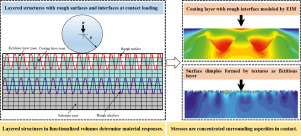当前位置:
X-MOL 学术
›
Int. J. Mech. Sci.
›
论文详情
Our official English website, www.x-mol.net, welcomes your
feedback! (Note: you will need to create a separate account there.)
Layered Structures with Rough Surfaces and Interfaces at Contact Loading
International Journal of Mechanical Sciences ( IF 7.1 ) Pub Date : 2020-07-01 , DOI: 10.1016/j.ijmecsci.2020.105611 Qingbing Dong , Yan Li , Jing Wei , Fengxia Lu
International Journal of Mechanical Sciences ( IF 7.1 ) Pub Date : 2020-07-01 , DOI: 10.1016/j.ijmecsci.2020.105611 Qingbing Dong , Yan Li , Jing Wei , Fengxia Lu

|
Abstract Layered structures are used in many applications because of their abilities to protect the surface from wear, corrosion and other damages, but the growth of a thin film inevitably generates a certain amount of roughness on the surface or between the adjacent layers. In this study, a numerical model is developed to address the stress concentrations at the roughened surface/interface under contact loading in plane-strain conditions. A square domain covering the structures of interest is proposed, and the gap between the horizontal edge of the domain and the rough surface is assumed to be filled with a fictitious layer, which may not possibly induce stresses, and the interactions are thus reasonably removed. The coating layer zone between the surface and interface is assumed as an infinitely extended inclusion and the Eshelby's Equivalent Inclusion Method (EIM) is employed to model the layered volumes. The Conjugate Gradient Method (CGM) is adopted to determine the surface pressure in contact areas and eigenstrains in equivalent inclusions. An algorithm mixing the techniques of discrete convolution and fast Fourier transform (DC–FFT) and DCD–FFT is employed to speed up the calculation. The model provides a useful tool to accurately capture the stresses within the roughened areas, and the analysis based on the model potentially gives insight views to enhance the contact behaviors of layered material systems. The model is also capable of solving problems of multi-layered materials as long as the layered volumes are specified.
中文翻译:

接触载荷时具有粗糙表面和界面的分层结构
摘要 层状结构因其能够保护表面免受磨损、腐蚀和其他损害而被用于许多应用,但薄膜的生长不可避免地在表面或相邻层之间产生一定的粗糙度。在这项研究中,开发了一个数值模型来解决在平面应变条件下接触载荷下粗糙表面/界面处的应力集中。提出了一个覆盖感兴趣结构的方形域,假设域的水平边缘和粗糙表面之间的间隙填充了一个虚拟层,这可能不会引起应力,因此可以合理地消除相互作用。表面和界面之间的涂层区域被假定为无限延伸的夹杂物和 Eshelby' ■ 等效包含法(EIM) 用于对分层体积进行建模。采用共轭梯度法 (CGM) 确定接触区域的表面压力和等效夹杂物中的本征应变。采用混合离散卷积和快速傅立叶变换 (DC-FFT) 和 DCD-FFT 技术的算法来加速计算。该模型提供了一种有用的工具来准确捕捉粗糙区域内的应力,基于该模型的分析可能会提供洞察力,以增强分层材料系统的接触行为。只要指定了分层体积,该模型也能够解决多层材料的问题。采用共轭梯度法 (CGM) 确定接触区域的表面压力和等效夹杂物中的本征应变。采用混合离散卷积和快速傅立叶变换 (DC-FFT) 和 DCD-FFT 技术的算法来加速计算。该模型提供了一种有用的工具来准确捕捉粗糙区域内的应力,基于该模型的分析可能会提供洞察力,以增强分层材料系统的接触行为。只要指定了分层体积,该模型也能够解决多层材料的问题。采用共轭梯度法 (CGM) 确定接触区域的表面压力和等效夹杂物中的本征应变。采用混合离散卷积和快速傅立叶变换 (DC-FFT) 和 DCD-FFT 技术的算法来加速计算。该模型提供了一种有用的工具来准确捕捉粗糙区域内的应力,基于该模型的分析可能会提供洞察力,以增强分层材料系统的接触行为。只要指定了分层体积,该模型也能够解决多层材料的问题。该模型提供了一种有用的工具来准确捕捉粗糙区域内的应力,基于该模型的分析可能会提供洞察力,以增强分层材料系统的接触行为。只要指定了分层体积,该模型也能够解决多层材料的问题。该模型提供了一种有用的工具来准确捕捉粗糙区域内的应力,基于该模型的分析可能会提供洞察力,以增强分层材料系统的接触行为。只要指定了分层体积,该模型也能够解决多层材料的问题。
更新日期:2020-07-01
中文翻译:

接触载荷时具有粗糙表面和界面的分层结构
摘要 层状结构因其能够保护表面免受磨损、腐蚀和其他损害而被用于许多应用,但薄膜的生长不可避免地在表面或相邻层之间产生一定的粗糙度。在这项研究中,开发了一个数值模型来解决在平面应变条件下接触载荷下粗糙表面/界面处的应力集中。提出了一个覆盖感兴趣结构的方形域,假设域的水平边缘和粗糙表面之间的间隙填充了一个虚拟层,这可能不会引起应力,因此可以合理地消除相互作用。表面和界面之间的涂层区域被假定为无限延伸的夹杂物和 Eshelby' ■ 等效包含法(EIM) 用于对分层体积进行建模。采用共轭梯度法 (CGM) 确定接触区域的表面压力和等效夹杂物中的本征应变。采用混合离散卷积和快速傅立叶变换 (DC-FFT) 和 DCD-FFT 技术的算法来加速计算。该模型提供了一种有用的工具来准确捕捉粗糙区域内的应力,基于该模型的分析可能会提供洞察力,以增强分层材料系统的接触行为。只要指定了分层体积,该模型也能够解决多层材料的问题。采用共轭梯度法 (CGM) 确定接触区域的表面压力和等效夹杂物中的本征应变。采用混合离散卷积和快速傅立叶变换 (DC-FFT) 和 DCD-FFT 技术的算法来加速计算。该模型提供了一种有用的工具来准确捕捉粗糙区域内的应力,基于该模型的分析可能会提供洞察力,以增强分层材料系统的接触行为。只要指定了分层体积,该模型也能够解决多层材料的问题。采用共轭梯度法 (CGM) 确定接触区域的表面压力和等效夹杂物中的本征应变。采用混合离散卷积和快速傅立叶变换 (DC-FFT) 和 DCD-FFT 技术的算法来加速计算。该模型提供了一种有用的工具来准确捕捉粗糙区域内的应力,基于该模型的分析可能会提供洞察力,以增强分层材料系统的接触行为。只要指定了分层体积,该模型也能够解决多层材料的问题。该模型提供了一种有用的工具来准确捕捉粗糙区域内的应力,基于该模型的分析可能会提供洞察力,以增强分层材料系统的接触行为。只要指定了分层体积,该模型也能够解决多层材料的问题。该模型提供了一种有用的工具来准确捕捉粗糙区域内的应力,基于该模型的分析可能会提供洞察力,以增强分层材料系统的接触行为。只要指定了分层体积,该模型也能够解决多层材料的问题。











































 京公网安备 11010802027423号
京公网安备 11010802027423号